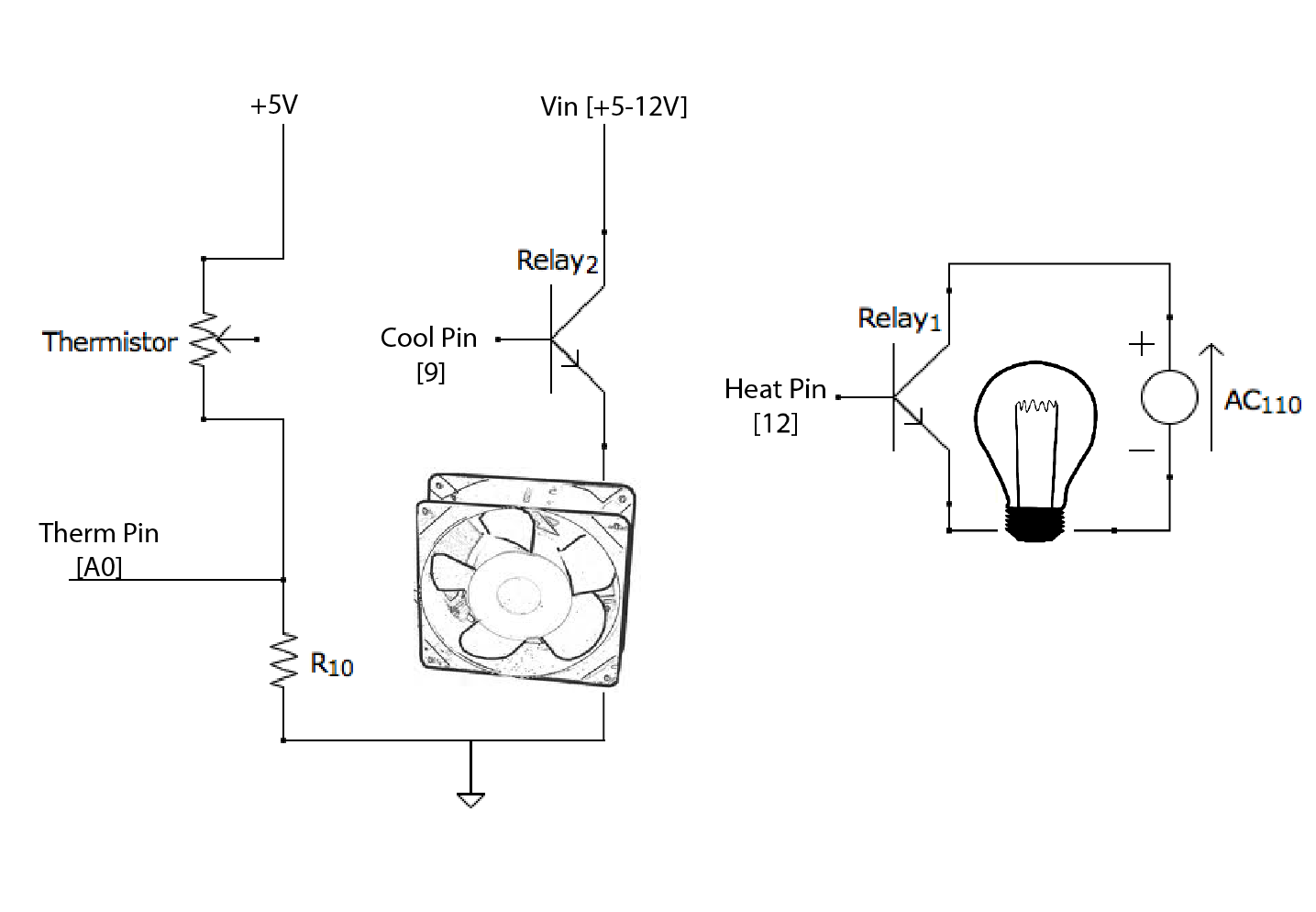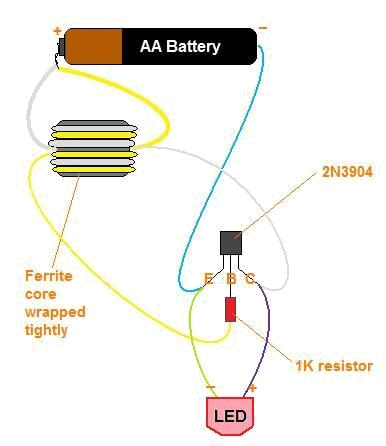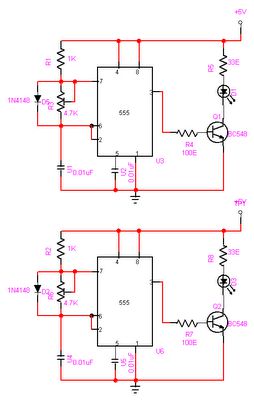
light bulb pcr

Based on a manual PCR machine constructed a few weeks ago, the Light Bulb PCR machine utilizes a light bulb and an old computer fan as its heating and cooling elements. Instead of the switches shown previously, the unit is now controlled by an Arduino Uno, with code available. It employs a thermistor, which is a resistor that allows more current to flow as heat increases, to monitor the temperature of the samples. The schematic indicates that the light bulb operates on 110 Volt AC, with the Arduino controlling a relay that turns the lamp circuit on and off. Both the Arduino and fan can be powered via USB or by a 12 V external power supply, which provides faster cooling rates. The relay systems are integrated onto the Maker Shield. In this design, the tubes are heated using a 150 Watt light bulb, although a lower wattage could also be used, and cooled by an old computer fan. The timing of the machine is reliable; a 1-minute elongation with 25 cycles results in approximately 2.25 hours. The prototype is constructed from 4-inch PVC pipe for several reasons: the availability of prefabricated attachments, consistent diameter, and familiarity in working with the material. The system consists of three layers based on a single 4-inch PVC coupling, held together with standard 4-inch pipe. The top layer is concave and accommodates the tubes and thermistor near the light bulb. The middle layer secures the fan and light bulb, while the bottom layer houses the control system and a safety switch. The temperature is monitored using a thermistor, which decreases resistance as temperature increases. The thermistor is wired such that as its temperature rises, more potential is fed into the Arduino's analog input pin. It is positioned inside one of the tube holes on the top unit. The machine can be operated using a laptop and the Arduino serial monitor, but it is also capable of functioning as a standalone device without cycle monitoring. The Arduino can be powered through the USB port, while the lamp circuit must be connected to a 110 Volt outlet.
The Light Bulb PCR machine is an innovative approach to polymerase chain reaction (PCR) technology, utilizing readily available components to create a functional and efficient system. The design leverages a light bulb, specifically a 150 Watt incandescent bulb, which provides the necessary heat for denaturation and annealing steps in the PCR process. The choice of an old computer fan for cooling is an economical solution that ensures rapid temperature changes between cycles, essential for the amplification process.
The use of an Arduino Uno as the central control unit allows for flexibility in programming and monitoring the PCR cycles. The relay interface provides a safe and effective way to control the high-voltage light bulb, ensuring that the Arduino can operate without direct exposure to high voltages. The integration of the Maker Shield simplifies the wiring and control of multiple relays, enhancing the overall reliability of the system.
The thermistor's role in temperature monitoring is critical, as accurate temperature readings are essential for successful PCR. The placement of the thermistor within the tube holes ensures that it accurately reflects the temperature of the samples being processed. This feedback loop allows the Arduino to adjust the heating element dynamically, maintaining optimal temperatures throughout the PCR cycles.
The structural design of the PCR machine, using 4-inch PVC pipe, not only provides a robust and stable framework but also allows for easy modifications and upgrades. The three-layer construction enables efficient organization of components, with the top layer facilitating sample placement, the middle layer housing the heating and cooling elements, and the bottom layer protecting the control circuitry.
In summary, the Light Bulb PCR machine represents a practical and cost-effective solution for conducting PCR experiments, suitable for educational purposes or small-scale research applications. Its design emphasizes ease of use, safety, and adaptability, making it an excellent choice for those interested in exploring PCR technology without the need for expensive commercial equipment.Based on this `manual` PCR machine I built a few weeks ago, the Light Bulb PCR machine uses a light bulb and an old computer fan as its heating and cooling elements: Instead of the switches pictured above, the unit is now controlled by an Arduino Uno, Code Available Here. It uses a thermistor (a resistor that allows more current to flow the more heat is available) to monitor the temperature of the samples. Here`s the schematic: The light bulb is run on 110 Volt AC, so the Arduino controls a relay which turns the lamp circuit on and off. Both the Arduino and Fan can be powered by USB or by a 12 V external power supply (which provides faster cooling rates).
I was able to put both of the relay systems onto the Maker Shield (which is awesome by the way, if you arduino you should look into getting one). This is what it ended up looking like: In this model, the tubes are heated using a 150 Watt light bulb (though you could definitely go with lower wattage) and cooled simply by an old computer fan I had lying around from one of many PC cannibalizations.
The timing of the machine is actually pretty solid - a 1 minute elongation with 25 cycles ends up being ~2. 25 hours. I`ll get ramp rates posted soon. I built this prototype out of 4`` PVC pipe for a few reasons: because there are many prefabricated attachments available, it`s easily available and has consistent diameter and because I have quite a bit of experience working with it.
There are three layers in the system all based on one 4`` PVC coupling and held together with regular 4`` pipe. The top layer is concave and holds the tubes and thermistor near the light bulb. The middle layer holds the fan and light bulb in place. The bottom layer encases the control system and safety switch in case something starts to smell. smoky. The temperature is monitored using a thermistor - basically a resistor that decreases resistance the hotter it gets.
The way I have it wired, the hotter the thermistor gets, the more potential feeds into the analog input pin on the arduino. The thermistor is placed inside one of the tube holes on the top unit. I still run the machine using my laptop and the arduino serial monitor, but it can work as a standalone device if you don`t want to monitor the cycles.
The arduino can be powered from the USB port while the lamp circuit needs to be plugged in to a 110 outlet. 🔗 External reference
The Light Bulb PCR machine is an innovative approach to polymerase chain reaction (PCR) technology, utilizing readily available components to create a functional and efficient system. The design leverages a light bulb, specifically a 150 Watt incandescent bulb, which provides the necessary heat for denaturation and annealing steps in the PCR process. The choice of an old computer fan for cooling is an economical solution that ensures rapid temperature changes between cycles, essential for the amplification process.
The use of an Arduino Uno as the central control unit allows for flexibility in programming and monitoring the PCR cycles. The relay interface provides a safe and effective way to control the high-voltage light bulb, ensuring that the Arduino can operate without direct exposure to high voltages. The integration of the Maker Shield simplifies the wiring and control of multiple relays, enhancing the overall reliability of the system.
The thermistor's role in temperature monitoring is critical, as accurate temperature readings are essential for successful PCR. The placement of the thermistor within the tube holes ensures that it accurately reflects the temperature of the samples being processed. This feedback loop allows the Arduino to adjust the heating element dynamically, maintaining optimal temperatures throughout the PCR cycles.
The structural design of the PCR machine, using 4-inch PVC pipe, not only provides a robust and stable framework but also allows for easy modifications and upgrades. The three-layer construction enables efficient organization of components, with the top layer facilitating sample placement, the middle layer housing the heating and cooling elements, and the bottom layer protecting the control circuitry.
In summary, the Light Bulb PCR machine represents a practical and cost-effective solution for conducting PCR experiments, suitable for educational purposes or small-scale research applications. Its design emphasizes ease of use, safety, and adaptability, making it an excellent choice for those interested in exploring PCR technology without the need for expensive commercial equipment.Based on this `manual` PCR machine I built a few weeks ago, the Light Bulb PCR machine uses a light bulb and an old computer fan as its heating and cooling elements: Instead of the switches pictured above, the unit is now controlled by an Arduino Uno, Code Available Here. It uses a thermistor (a resistor that allows more current to flow the more heat is available) to monitor the temperature of the samples. Here`s the schematic: The light bulb is run on 110 Volt AC, so the Arduino controls a relay which turns the lamp circuit on and off. Both the Arduino and Fan can be powered by USB or by a 12 V external power supply (which provides faster cooling rates).
I was able to put both of the relay systems onto the Maker Shield (which is awesome by the way, if you arduino you should look into getting one). This is what it ended up looking like: In this model, the tubes are heated using a 150 Watt light bulb (though you could definitely go with lower wattage) and cooled simply by an old computer fan I had lying around from one of many PC cannibalizations.
The timing of the machine is actually pretty solid - a 1 minute elongation with 25 cycles ends up being ~2. 25 hours. I`ll get ramp rates posted soon. I built this prototype out of 4`` PVC pipe for a few reasons: because there are many prefabricated attachments available, it`s easily available and has consistent diameter and because I have quite a bit of experience working with it.
There are three layers in the system all based on one 4`` PVC coupling and held together with regular 4`` pipe. The top layer is concave and holds the tubes and thermistor near the light bulb. The middle layer holds the fan and light bulb in place. The bottom layer encases the control system and safety switch in case something starts to smell. smoky. The temperature is monitored using a thermistor - basically a resistor that decreases resistance the hotter it gets.
The way I have it wired, the hotter the thermistor gets, the more potential feeds into the analog input pin on the arduino. The thermistor is placed inside one of the tube holes on the top unit. I still run the machine using my laptop and the arduino serial monitor, but it can work as a standalone device if you don`t want to monitor the cycles.
The arduino can be powered from the USB port while the lamp circuit needs to be plugged in to a 110 outlet. 🔗 External reference





